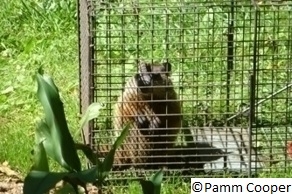
The woodchuck, Marmota monax, also known as a groundhog or whistle pig, is a member of the rodent family Sciuridae. It has a compact, hefty body, short, strong legs with long, curved claws on the forefeet for digging and a short tail. It is heavily furred and dark brown in color, weighs from five to ten pounds and is 16 to 20 inches long. Although they are slow runners, woodchucks are alert and can quickly move into their dens when alarmed.
Life History and Habits
Woodchucks hibernate during the winter, becoming active in late February and March. Mating occurs in March and a single litter of two to four young is produced annually. The young are weaned by late June or early July, and soon thereafter strike out on their own-usually occupying old, abandoned dens. Older chucks dig the numerous new burrows, which appear during the late summer. Woodchucks are active during the daylight hours, and their range is 50 to 100 feet from their dens.
The den and burrows are extensive and may be used for several years. Burrows may be as deep as five feet and up to 60 feet in length. Woodchucks seem to prefer to construct burrows on or near farmland where crops grow. They frequently may be found in woodlands or in abandoned farmlands and occasionally in urban areas where the combination of food and cover provides a satisfactory habitat.
Woodchucks are voracious feeders. In the early morning and evening periods of the summer, woodchucks actively feed on succulent, green vegetation. They are storing body fat in preparation for hibernation during late fall, usually near the end of October or early November.
Woodchucks feed primarily on vegetables, trees, grasses and legumes. Their favorite foods include various beans, cole crops (broccoli, cabbage, cauliflower etc.), carrot tops, clover, squash and peas. Their gnawing and clawing can kill young fruit trees. Gnawing occurs on the main stems of trees and lower branches close to the burrows and is easily distinguished from vole gnawing by the large size of the incisor teeth marks (1/4 to 3/8 inch wide). This is done as a way to control tooth growth. Their burrowing habits produce mounds of earth and burrow holes that present hazards. The burrows have a main entrance and at least one back door. The main entrance to the burrow is a ten to twelve inch in diameter hole with a mound of soil next to it. There may be well-used path visible leading from the burrow.
Damage Control
1. Wire fencing will help keep woodchucks out of nursery areas and small plantings. Bury the lower edge 10 to 12 inches deep in the soil to prevent burrowing under the fence. Because woodchucks are good climbers, the fence should be three to four feet high with the top 12” left loose and bent outward at a 90° angle.
2. Live trapping and relocating is legal in the state of Connecticut for species that do not carry rabies.Use a have-a-heart live trap baited with a cut up piece of fruit to attract them. Be sure to check the trap daily so that a woodchuck or perhaps another non-target creature does not expire in it.

3. Woodchucks can be hunted most of the year with no daily or seasonal limits (2015); check the current Connecticut Department of Energy and Environmental Protection hunting and trapping guide for periods when the season is closed. If safety requirements are satisfied, landowners and their hunting friends can help reduce the number of woodchucks. Even concentrated hunting may not eliminate woodchucks and some of the problems they create. Landowners and hunters should agree on arrangements for hunting. This will aid in reducing woodchucks and their damage, provide recreational hunting and avoid unsafe practices in the field. Use of rifles is restricted in some towns. Check with local authorities before hunting.
4. Commercial gas cartridges filled with slow-burning chemicals (usually a combination carbon, potassium or sodium nitrate, and sulfur) are available at garden and farm supply stores. All entrances must be sealed with soil or piece of turf big enough to tightly cover the holes. Ignite and place the cartridge as far back into the burrow as you can. Then seal the main entrance. As the cartridges burn, carbon monoxide and sulfur dioxide fill the tunnels and kill the woodchuck. Before using these cartridges, read and follow all instructions and cautions on the label. The best time of day to find the woodchuck in its burrow is mid day when they go in to stay cool.
5. No poisons or poisonous baits are registered for woodchuck control in Connecticut.
Revised by UConn Home and Garden Education Center 2016.